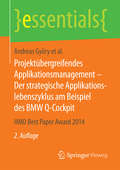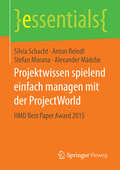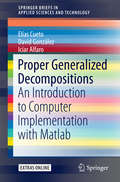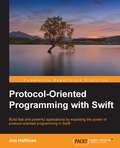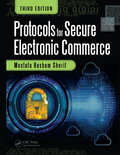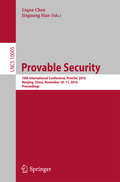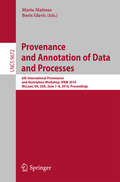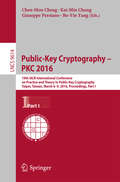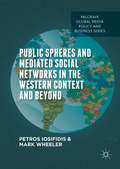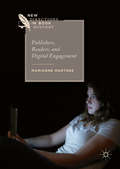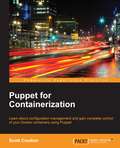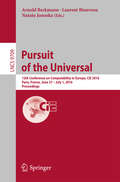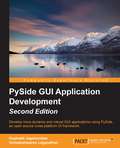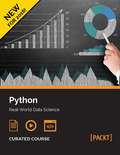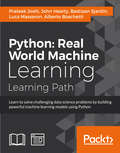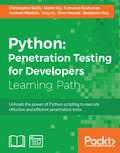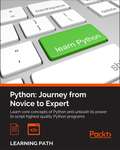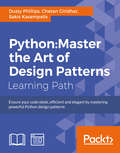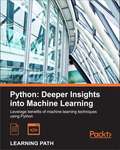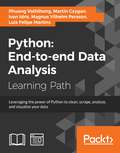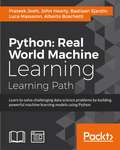- Table View
- List View
Projektübergreifendes Applikationsmanagement - Der strategische Applikationslebenszyklus am Beispiel des BMW Q-Cockpit: HMD Best Paper Award 2014 (essentials)
by Falk Uebernickel Walter Brenner Andreas Györy Anne Cleven Günter SeeserIn diesem essential werden die übergeordneten Zielsetzungen der Applikationsentwicklung und einführung auf vier Evolutionsphasen verteilt, um unterschiedlichen Anforderungen gerecht zu werden. Durch den daraus resultierenden strategischen Applikationslebenszyklus (SALZ) können innovative Neuentwicklungen in frühen Phasen von technischen und architekturbezogenen Vorgaben befreit und agil entwickelt werden, während für operative Kernsysteme weiterhin ein ausführliches Änderungsmanagement betrieben wird. Damit bietet der SALZ auch die Grundlage, um in Unternehmen IT-Entwicklungsprojekte adaptiv mit unterschiedlichen Geschwindigkeiten zu realisieren. Alle Erkenntnisse werden am erfolgreichen Praxisbeispiel des Q-Cockpit-Projekts demonstriert.
Projektwissen spielend einfach managen mit der ProjectWorld: HMD Best Paper Award 2015 (essentials)
by Silvia Schacht Anton Reindl Stefan Morana Alexander MädcheDie Autoren zeigen einen neuen Weg auf, gamifizierte Wissensmanagementsysteme mit der Anwendung spielerischer Elemente zu gestalten, und beschreiben die Anforderungserhebung, die Gestaltung und Evaluation des Systems. Hierbei gehen sie auf die theoretischen Grundlagen sowie die Umsetzung und Nutzung in einem Unternehmen ein. Mithilfe von Gamification-Mechanismen sollen Projektteams dazu motiviert werden, ihr Wissen und ihre Erfahrungen zu dokumentieren und in anderen Projekten wiederzuverwenden. Damit erh#65533;lt der Leser einen umfassenden Einblick in die Theorie und Praxis des modernen Wissensmanagements in Projekten.
Proper Generalized Decompositions
by Elías Cueto David González Icíar AlfaroThis book is intended to help researchers overcome the entrance barrier to Proper Generalized Decomposition (PGD), by providing a valuable tool to begin the programming task. Detailed Matlab Codes are included for every chapter in the book, in which the theory previously described is translated into practice. Examples include parametric problems, non-linear model order reduction and real-time simulation, among others. Proper Generalized Decomposition (PGD) is a method for numerical simulation in many fields of applied science and engineering. As a generalization of ProperOrthogonal Decomposition or Principal Component Analysis to an arbitrary numberof dimensions, PGD is able to provide the analyst with very accurate solutionsfor problems defined in high dimensional spaces, parametric problems and evenreal-time simulation.
Protocol-Oriented Programming with Swift
by Jon HoffmanBuild fast and powerful applications by exploiting the power of protocol-oriented programming in Swift About This Book * The only book that shows how to harness the power of Protocol-Oriented Programming in Swift to build real-world applications, * Get familiar with the protocol focused approach of application development, * Increase the overall productivity and performance of applications with Protocol Oriented Programming. Who This Book Is For This book is for Swift developers who want to learn and implement protocol oriented programming in their real world applications. What You Will Learn * The difference between Object-Oriented programming and Protocol-Oriented programming * The difference between reference and value types and when to use each * How we can leverage tuples to reduce the complexity of our code * What are protocols and how to use them * How to implement protocol extensions to create a very flexible code base * How to implement several design patterns in a Protocol-Oriented approach * How to solve real world design issue with protocol oriented programming In Detail At the heart of Swift's design is an incredibly powerful idea: protocol-oriented programming. Its many benefits include better code maintainability, increased developer productivity and superior application performance. The book will teach the reader how to apply the ideas behind the protocol oriented programing paradigm to improve the code they write. This book will introduce the readers to the world of protocol-oriented programming in Swift and will demonstrate the ideas behind this new programming paradigm with real world examples. In addition to learning the concepts of Protocol Oriented programming, it also shows the reader how to reduce the complexity of their codebase using protocol extensions. Beginning with how to create simple protocols, readers will learn how to extend protocols and also to assign behaviors to them. By the end of this book readers will be able to harness the power of protocol-oriented programming to build real world applications. Style and approach In its latest release of Swift, Apple has introduced Protocol Extensions as a new feature at the heart of Swifts design making Swift 2 a protocol-oriented language. Protocol oriented programming being a less explored OOP paradigm, there is little guidance on hot to take advantage of protocol extensions in real-world applications. In addition to offering an in-depth coverage of protocol oriented programming and its concepts, this book also explains how a developer can leverage these features to build powerful, real-world applications
Protocols for Secure Electronic Commerce (Advanced And Emerging Communications Technologies Ser.)
by Mostafa Hashem SherifProtocols for Secure Electronic Commerce, Third Edition presents a compendium of protocols for securing electronic commerce, or e-commerce, in consumer- and business-to-business applications. Attending to a variety of electronic payment systems currently in use around the globe, this edition: <Li>Updates all chapters to reflect the latest technical advances and developments in areas such as mobile commerce <Li>Adds a new chapter on Bitcoin and other cryptocurrencies that did not exist at the time of the previous edition's publication <Li>Increases the coverage of PayPal in accordance with PayPal’s amplified role for consumers and businesses <Li>Expands the discussion of bank cards, dedicating a full chapter to magnetic stripe cards and a full chapter to chip-and-PIN technology <P><P>Protocols for Secure Electronic Commerce, Third Edition offers a state-of-the-art overview of best practices for the security of e-commerce, complete with end-of-chapter review questions and an extensive bibliography of specialized references. A Solutions Manual and PowerPoint slides are available with qualifying course adoption.
Provable Security
by Liqun Chen Jinguang HanThis book constitutes the refereed proceedings of the 10th International Conference on Provable Security, ProvSec 2016, held in Nanjing, China, in November 2016. The 17 full papers and 6 short papers presented were carefully reviewed and selected from 79 submissions. The papers are grouped in topical sections on attribute/role-based cryptography, data in cloud, searchable encryption, key management, encryption, leakage analysis, homomorphic encryption.
Provenance and Annotation of Data and Processes
by Boris Glavic Marta MattosoThis book constitutes the refereed proceedings of the 6th International Provenance and Annotation Workshop, IPAW 2016, held in McLean, VA, USA, in June 2016. The 12 revised full papers, 14 poster papers, and 2 demonstration papers presented were carefully reviewed and selected from 54 submissions. The papers feature state-of-the-art research and practice around the automatic capture, representation, and use of provenance. They are organized in topical sections on provenance capture, provenance analysis and visualization, and provenance models and applications.
Psychology of the Digital Age
by John SulerBased on two decades of participant-observation field research in diverse online environments, this engaging book offers insights for improving lifestyles and enhancing wellbeing in the digital age. John R. Suler, a founder of the field of cyberpsychology, explains its fundamental principles across a wide variety of topics, including online identity management, disinhibition, communication via text and photographs, intimacy and misunderstandings in online relationships, conflicting attitudes toward social media, addiction, deviant behavior, virtual reality, artificial intelligence, and media overload. He provides a new framework, the 'Eight Dimensions of Cyberpsychology Architecture', which researchers, students, and general readers interested in cyberpsychology can apply as a valuable tool for creating and understanding different digital realms. Psychology of the Digital Age focuses on the individual, shedding new light on our conscious as well as subconscious reactions to online experiences and our intrinsic human need to self-actualize.
The Psychology of the Internet
by Patricia WallaceThis timely volume explores the psychological aspects of cyberspace, a virtual world in which people from around the globe are acting and interacting in many new, unusual, and occasionally alarming ways. Drawing on research in the social sciences, communications, business, and other fields, Patricia Wallace examines how the online environment can influence the way we behave, sometimes for the better, sometimes not. Our own online behavior then becomes part of the Internet's psychological environment for others, creating opportunities for shaping the way this new territory for human interaction is unfolding. Since the Internet--and our experience within it--is still young, we have a rare window of opportunity to influence the course of its development. With a new preface that incorporates many of the changes online and in the field since the hardcover edition was published, the paperback edition of The Psychology of the Internet includes the latest coverage of e-commerce, workplace surveillance and datamining, all areas of recent intense public concern. Patricia M. Wallace is Executive Director of the Center for Knowledge and Information Management at the Robert H. Smith School of Business, University of Maryland. She is author of an interactive psychology CD-ROM called PRISM and of the textbook Introduction to Psychology, Fourth Edition (with Jeffrey Goldstein). Dr. Wallace is also the principal investigator on grants from the Annenberg Projects/Corporation for Public Broadcasting dealing with language learning through CD-ROMs and the Internet.
Public Interests: Media Advocacy and Struggles over U.S. Television
by Allison PerlmanNearly as soon as television began to enter American homes in the late 1940s, social activists recognized that it was a powerful tool for shaping the nation's views. By targeting broadcast regulations and laws, both liberal and conservative activist groups have sought to influence what America sees on the small screen. Public Interests describes the impressive battles that these media activists fought and charts how they tried to change the face of American television. Allison Perlman looks behind the scenes to track the strategies employed by several key groups of media reformers, from civil rights organizations like the NAACP to conservative groups like the Parents Television Council. While some of these campaigns were designed to improve the representation of certain marginalized groups in television programming, as Perlman reveals, they all strove for more systemic reforms, from early efforts to create educational channels to more recent attempts to preserve a space for Spanish-language broadcasting. Public Interests fills in a key piece of the history of American social reform movements, revealing pressure groups' deep investments in influencing both television programming and broadcasting policy. Vividly illustrating the resilience, flexibility, and diversity of media activist campaigns from the 1950s onward, the book offers valuable lessons that can be applied to current battles over the airwaves.
Public-Key Cryptography – PKC 2016: 19th IACR International Conference on Practice and Theory in Public-Key Cryptography, Taipei, Taiwan, March 6-9, 2016, Proceedings, Part I (Lecture Notes in Computer Science #9614)
by Chen-Mou Cheng Kai-Min Chung Giuseppe Persiano Bo-Yin YangThe two-volume set LNCS 9614 and 9615 constitutes the refereed proceedings of the 19th IACR International Conference on the Practice and Theory in Public-Key Cryptography, PKC 2016, held in Taipei, Taiwan, in March 2016.The 34 revised papers presented were carefully reviewed and selected from 143 submissions. They are organized in topical sections named: CCA security, functional encryption, identity-based encryption, signatures, cryptanalysis, leakage-resilient and circularly secure encryption, protocols, and primitives.
Public-Key Cryptography - PKC 2016
by Bo-Yin Yang Giuseppe Persiano Kai-Min Chung Chen-Mou ChengThetwo-volume set LNCS 9614 and 9615 constitutes the refereed proceedings of the 19thIACR International Conference on the Practiceand Theory in Public-Key Cryptography, PKC 2016, held in Taipei, Taiwan, in March2016. The34 revised papers presented were carefully reviewed and selected from 143submissions. They are organized in topical sections named: CCA security,functional encryption, identity-based encryption, signatures, cryptanalysis,leakage-resilient and circularly secure encryption, protocols, and primitives.
Public Spheres and Mediated Social Networks in the Western Context and Beyond
by Petros Iosifidis Mark WheelerSocial media is said to radically change the way in which public communication takes place: information diffuses faster and can reach a large number of people, but what makes the process so novel is that online networks can empower people to compete with traditional broadcasters or public figures. This book critically interrogates the contemporary relevance of social networks as a set of economic, cultural and political enterprises and as a public sphere in which a variety of political and socio-cultural demands can be met. It examines policy, regulatory and socio-cultural issues arising from the transformation of communication to a multi-layered sphere of online and social networks. The central theme of the book is to address the following questions: Are online and social networks an unstoppable democratizing and mobilizing force? Is there a need for policy and intervention to ensure the development of comprehensive and inclusive social networking frameworks? Social media are viewed both as a tool that allows citizens to influence policymaking, and as an object of new policies and regulations, such as data retention, privacy and copyright laws, around which citizens are mobilizing.
Publishers, Readers, and Digital Engagement
by Marianne MartensThis book demonstrates how the roles of "author," "marketer," and "reviewer" are being redefined, as online environments enable new means for young adults to participate in the books they love. Prior to the expansion of digital technologies around reading, teachers, parents and librarians were the primary gatekeepers responsible for getting books into the hands of young people. Now publishers can create disintermediated digital enclosures in which they can communicate directly with their reading audience. This book exposes how teens contribute their immaterial and affective labor as they engage in participatory reading experiences via publishers' and authors' interactive websites and use of social media, and how in turn publishers are able to use such labor as they get invaluable market research, peer-to-peer recommendations, and even content which can be used in other projects -- all virtually free-of-charge.
Puppet for Containerization
by Scott CoultonThis book is designed for system administrators who are looking to explore containerization. Intermediate experience and expertise with Puppet is presumed.
Pursuit of the Universal
by Arnold Beckmann Laurent Bienvenu Nataša JonoskaThis book constitutes the refereed proceedings of the 12th Conference on Computability in Europe, CiE 2016, held in Paris, France, in June/July 2016. The 18 revised full papers and 19 invited papers and invited extended abstracts were carefully reviewed and selected from 40 submissions. The conference CiE 2016 has six special sessions - two sessions, cryptography and information theory and symbolic dynamics, are organized for the first time in the conference series. In addition to this new developments in areas frequently covered in the CiE conference series were addressed in the following sessions: computable and constructive analysis; computation in biological systems; history and philosophy of computing; weak arithmetic.
PySide GUI Application Development - Second Edition
by Gopinath Jaganmohan Venkateshwaran LoganathanDevelop more dynamic and robust GUI applications using PySide, an open source cross-platform UI framework About This Book * Designed for beginners to help you get started with GUI application development * Develop your own applications by creating customized widgets and dialogs * Written in a simple and elegant structure so you easily understand how to program various GUI components Who This Book Is For This book is written for Python programmers who want to learn about GUI programming. It is also suitable for those who are new to Python but are familiar with object-oriented programming. What You Will Learn * Program GUI applications in an easy and efficient way * Download and install PySide, a cross-platform GUI development toolkit for Python * Create menus, toolbars, status bars, and child windows * Develop a text editor application on your own * Connect your GUI to a database and manage it * Execute SQL queries by handling databases In Detail Elegantly-built GUI applications are always a massive hit among users. PySide is an open source software project that provides Python bindings for the Qt cross-platform UI framework. Combining the power of Qt and Python, PySide provides easy access to the Qt framework for Python developers and also acts as an excellent rapid application development platform. This book will take you through everything you need to know to develop UI applications. You will learn about installing and building PySide in various major operating systems as well as the basics of GUI programming. The book will then move on to discuss event management, signals and slots, and the widgets and dialogs available with PySide. Database interaction and manipulation is also covered. By the end of this book, you will be able to program GUI applications efficiently and master how to develop your own applications and how to run them across platforms. Style and approach This is an accessible and practical guide to developing GUIs for Python applications.
Python: Real-World Data Science
by Dusty Phillips Fabrizio Romano Martin Czygan Phuong Vo.T.H Robert Layton Sebastian RaschkaUnleash the power of Python and its robust data science capabilities About This Book • Unleash the power of Python 3 objects • Learn to use powerful Python libraries for effective data processing and analysis • Harness the power of Python to analyze data and create insightful predictive models • Unlock deeper insights into machine learning with this vital guide to cutting-edge predictive analytics Who This Book Is For Entry-level analysts who want to enter in the data science world will find this course very useful to get themselves acquainted with Python's data science capabilities for doing real-world data analysis. What You Will Learn • Install and setup Python • Implement objects in Python by creating classes and defining methods • Get acquainted with NumPy to use it with arrays and array-oriented computing in data analysis • Create effective visualizations for presenting your data using Matplotlib • Process and analyze data using the time series capabilities of pandas • Interact with different kind of database systems, such as file, disk format, Mongo, and Redis • Apply data mining concepts to real-world problems • Compute on big data, including real-time data from the Internet • Explore how to use different machine learning models to ask different questions of your data In Detail The Python: Real-World Data Science course will take you on a journey to become an efficient data science practitioner by thoroughly understanding the key concepts of Python. This learning path is divided into four modules and each module are a mini course in their own right, and as you complete each one, you'll have gained key skills and be ready for the material in the next module. The course begins with getting your Python fundamentals nailed down. After getting familiar with Python core concepts, it's time that you dive into the field of data science. In the second module, you'll learn how to perform data analysis using Python in a practical and example-driven way. The third module will teach you how to design and develop data mining applications using a variety of datasets, starting with basic classification and affinity analysis to more complex data types including text, images, and graphs. Machine learning and predictive analytics have become the most important approaches to uncover data gold mines. In the final module, we'll discuss the necessary details regarding machine learning concepts, offering intuitive yet informative explanations on how machine learning algorithms work, how to use them, and most importantly, how to avoid the common pitfalls. Style and approach This course includes all the resources that will help you jump into the data science field with Python and learn how to make sense of data. The aim is to create a smooth learning path that will teach you how to get started with powerful Python libraries and perform various data science techniques in depth.
Python: Real World Machine Learning
by Prateek Joshi Luca Massaron John Hearty Bastiaan Sjardin Alberto BoschettiLearn to solve challenging data science problems by building powerful machine learning models using Python About This Book * Understand which algorithms to use in a given context with the help of this exciting recipe-based guide * This practical tutorial tackles real-world computing problems through a rigorous and effective approach * Build state-of-the-art models and develop personalized recommendations to perform machine learning at scale Who This Book Is For This Learning Path is for Python programmers who are looking to use machine learning algorithms to create real-world applications. It is ideal for Python professionals who want to work with large and complex datasets and Python developers and analysts or data scientists who are looking to add to their existing skills by accessing some of the most powerful recent trends in data science. Experience with Python, Jupyter Notebooks, and command-line execution together with a good level of mathematical knowledge to understand the concepts is expected. Machine learning basic knowledge is also expected. What You Will Learn * Use predictive modeling and apply it to real-world problems * Understand how to perform market segmentation using unsupervised learning * Apply your new-found skills to solve real problems, through clearly-explained code for every technique and test * Compete with top data scientists by gaining a practical and theoretical understanding of cutting-edge deep learning algorithms * Increase predictive accuracy with deep learning and scalable data-handling techniques * Work with modern state-of-the-art large-scale machine learning techniques * Learn to use Python code to implement a range of machine learning algorithms and techniques In Detail Machine learning is increasingly spreading in the modern data-driven world. It is used extensively across many fields such as search engines, robotics, self-driving cars, and more. Machine learning is transforming the way we understand and interact with the world around us. In the first module, Python Machine Learning Cookbook, you will learn how to perform various machine learning tasks using a wide variety of machine learning algorithms to solve real-world problems and use Python to implement these algorithms. The second module, Advanced Machine Learning with Python, is designed to take you on a guided tour of the most relevant and powerful machine learning techniques and you'll acquire a broad set of powerful skills in the area of feature selection and feature engineering. The third module in this learning path, Large Scale Machine Learning with Python, dives into scalable machine learning and the three forms of scalability. It covers the most effective machine learning techniques on a map reduce framework in Hadoop and Spark in Python. This Learning Path will teach you Python machine learning for the real world. The machine learning techniques covered in this Learning Path are at the forefront of commercial practice. This Learning Path combines some of the best that Packt has to offer in one complete, curated package. It includes content from the following Packt products: * Python Machine Learning Cookbook by Prateek Joshi * Advanced Machine Learning with Python by John Hearty * Large Scale Machine Learning with Python by Bastiaan Sjardin, Alberto Boschetti, Luca Massaron Style and approach This course is a smooth learning path that will teach you how to get started with Python machine learning for the real world, and develop solutions to real-world problems. Through this comprehensive course, you'll learn to create the most effective machine learning techniques from scratch and more!
Python: Penetration Testing for Developers
by Mohit Terry Ip Andrew Mabbitt Cameron Buchanan Dave Mound Benjamin May Christopher DuffyUnleash the power of Python scripting to execute effective and efficient penetration tests About This Book * Sharpen your pentesting skills with Python * Develop your fluency with Python to write sharper scripts for rigorous security testing * Get stuck into some of the most powerful tools in the security world Who This Book Is For If you are a Python programmer or a security researcher who has basic knowledge of Python programming and wants to learn about penetration testing with the help of Python, this course is ideal for you. Even if you are new to the field of ethical hacking, this course can help you find the vulnerabilities in your system so that you are ready to tackle any kind of attack or intrusion. What You Will Learn * Familiarize yourself with the generation of Metasploit resource files and use the Metasploit Remote Procedure Call to automate exploit generation and execution * Exploit the Remote File Inclusion to gain administrative access to systems with Python and other scripting languages * Crack an organization's Internet perimeter and chain exploits to gain deeper access to an organization's resources * Explore wireless traffic with the help of various programs and perform wireless attacks with Python programs * Gather passive information from a website using automated scripts and perform XSS, SQL injection, and parameter tampering attacks * Develop complicated header-based attacks through Python In Detail Cybercriminals are always one step ahead, when it comes to tools and techniques. This means you need to use the same tools and adopt the same mindset to properly secure your software. This course shows you how to do just that, demonstrating how effective Python can be for powerful pentesting that keeps your software safe. Comprising of three key modules, follow each one to push your Python and security skills to the next level. In the first module, we'll show you how to get to grips with the fundamentals. This means you'll quickly find out how to tackle some of the common challenges facing pentesters using custom Python tools designed specifically for your needs. You'll also learn what tools to use and when, giving you complete confidence when deploying your pentester tools to combat any potential threat. In the next module you'll begin hacking into the application layer. Covering everything from parameter tampering, DDoS, XXS and SQL injection, it will build on the knowledge and skills you learned in the first module to make you an even more fluent security expert. Finally in the third module, you'll find more than 60 Python pentesting recipes. We think this will soon become your trusted resource for any pentesting situation. This Learning Path combines some of the best that Packt has to offer in one complete, curated package. It includes content from the following Packt products: * Learning Penetration Testing with Python by Christopher Duffy * Python Penetration Testing Essentials by Mohit * Python Web Penetration Testing Cookbook by Cameron Buchanan,Terry Ip, Andrew Mabbitt, Benjamin May and Dave Mound Style and approach This course provides a quick access to powerful, modern tools, and customizable scripts to kick-start the creation of your own Python web penetration testing toolbox.
Python: Journey from Novice to Expert
by Rick Van Hattem Fabrizio Romano Dusty PhillipsLearn core concepts of Python and unleash its power to script highest quality Python programs About This Book * Develop a strong set of programming skills with Pyhton that you will be able to express in any situation, on every platform, thanks to Python's portability * Stop writing scripts and start architecting programs by applying object-oriented programming techniques in Python * Learn the trickier aspects of Python and put it in a structured context for deeper understanding of the language Who This Book Is For This course is meant for programmers who wants to learn Python programming from a basic to an expert level. The course is mostly self-contained and introduces Python programming to a new reader and can help him become an expert in this trade. What You Will Learn * Get Python up and running on Windows, Mac, and Linux in no time * Grasp the fundamental concepts of coding, along with the basics of data structures and control flow * Understand when to use the functional or the object-oriented programming approach * Extend class functionality using inheritance * Exploit object-oriented programming in key Python technologies, such as Kivy and Django * Understand how and when to use the functional programming paradigm * Use the multiprocessing library, not just locally but also across multiple machines In Detail Python is a dynamic and powerful programming language, having its application in a wide range of domains. It has an easy-to-use, simple syntax, and a powerful library, which includes hundreds of modules to provide routines for a wide range of applications, thus making it a popular language among programing enthusiasts.This course will take you on a journey from basic programming practices to high-end tools and techniques giving you an edge over your peers. It follows an interesting learning path, divided into three modules. As you complete each one, you'll have gained key skills and get ready for the material in the next module.The first module will begin with exploring all the essentials of Python programming in an easy-to-understand way. This will lay a good foundation for those who are interested in digging deeper. It has a practical and example-oriented approach through which both the introductory and the advanced topics are explained. Starting with the fundamentals of programming and Python, it ends by exploring topics, like GUIs, web apps, and data science.In the second module you will learn about object oriented programming techniques in Python. Starting with a detailed analysis of object-oriented technique and design, you will use the Python programming language to clearly grasp key concepts from the object-oriented paradigm. This module fully explains classes, data encapsulation, inheritance, polymorphism, abstraction, and exceptions with an emphasis on when you can use each principle to develop well-designed software.With a good foundation of Python you will move onto the third module which is a comprehensive tutorial covering advanced features of the Python language. Start by creating a project-specific environment using venv. This will introduce you to various Pythonic syntax and common pitfalls before moving onto functional features and advanced concepts, thereby gaining an expert level knowledge in programming and teaching how to script highest quality Python programs. Style and approach This course follows a theory-cum-practical approach having all the ingredients that will help you jump into the field of Python programming as a novice and grow-up as an expert. The aim is to create a smooth learning path that will teach you how to get started with Python and carry out expert-level programming techniques at the end of course.
Python: Master the Art of Design Patterns
by Sakis Kasampalis Dusty Phillips Chetan GiridharEnsure your code is sleek, efficient and elegant by mastering powerful Python design patterns About This Book * Learn all about abstract design patterns and how to implement them in Python 3 * Understand the structural, creational, and behavioral Python design patterns * Get to know the context and application of design patterns to solve real-world problems in software architecture, design, and application development * Discover how to simplify Design Pattern implementation using the power of Python 3 Who This Book Is For If you have basic Python skills and wish to learn in depth how to correctly apply appropriate design patterns, this course is tailor made for you. What You Will Learn * Discover what design patterns are and how to apply them to writing Python * Implement objects in Python by creating classes and defining methods * Separate related objects into a taxonomy of classes and describe the properties and behaviors of those objects via the class interface * Understand when to use object-oriented features, and more importantly when not to use them * Get to know proven solutions to common design issues * Explore the design principles that form the basis of software design, such as loose coupling, the Hollywood principle, and the Open Close principle, among others * Use Structural Design Patterns and find out how objects and classes interact to build larger applications * Improve the productivity and code base of your application using Python design patterns * Secure an interface using the Proxy pattern In Detail Python is an object-oriented scripting language that is used in everything from data science to web development. Known for its simplicity, Python increases productivity and minimizes development time. Through applying essential software engineering design patterns to Python, Python code becomes even more efficient and reusable from project to project. This learning path takes you through every traditional and advanced design pattern best applied to Python code, building your skills in writing exceptional Python. Divided into three distinct modules, you'll go from foundational to advanced concepts by following a series of practical tutorials. Start with the bedrock of Python programming - the object-oriented paradigm. Rethink the way you work with Python as you work through the Python data structures and object-oriented techniques essential to modern Python programming. Build your confidence as you learn Python syntax, and how to use OOP principles with Python tools such as Django and Kivy. In the second module, run through the most common and most useful design patterns from a Python perspective. Progress through Singleton patterns, Factory patterns, Facade patterns and more all with detailed hands-on guidance. Enhance your professional abilities in in software architecture, design, and development. In the final module, run through the more complex and less common design patterns, discovering how to apply them to Python coding with the help of real-world examples. Get to grips with the best practices of writing Python, as well as creating systems architecture and troubleshooting issues. This Learning Path combines some of the best that Packt has to offer in one complete, curated package. It includes content from the following Packt products: * Python 3 Object-Oriented Programming - Second Edition by Dusty Phillips * Learning Python Design Patterns - Second Edition by Chetan Giridhar * Mastering Python Design Patterns by Sakis Kasampalis Style and approach Advance your Python code through three distinct modules that each build on preceding content. Get the complete coverage of Python design patterns you need to write elegant and efficient code that's reusable and powerful.
Python: Deeper Insights into Machine Learning
by John Hearty David Julian Sebastian RaschkaLeverage benefits of machine learning techniques using Python About This Book * Improve and optimise machine learning systems using effective strategies. * Develop a strategy to deal with a large amount of data. * Use of Python code for implementing a range of machine learning algorithms and techniques. Who This Book Is For This title is for data scientist and researchers who are already into the field of data science and want to see machine learning in action and explore its real-world application. Prior knowledge of Python programming and mathematics is must with basic knowledge of machine learning concepts. What You Will Learn * Learn to write clean and elegant Python code that will optimize the strength of your algorithms * Uncover hidden patterns and structures in data with clustering * Improve accuracy and consistency of results using powerful feature engineering techniques * Gain practical and theoretical understanding of cutting-edge deep learning algorithms * Solve unique tasks by building models * Get grips on the machine learning design process In Detail Machine learning and predictive analytics are becoming one of the key strategies for unlocking growth in a challenging contemporary marketplace. It is one of the fastest growing trends in modern computing, and everyone wants to get into the field of machine learning. In order to obtain sufficient recognition in this field, one must be able to understand and design a machine learning system that serves the needs of a project. The idea is to prepare a learning path that will help you to tackle the real-world complexities of modern machine learning with innovative and cutting-edge techniques. Also, it will give you a solid foundation in the machine learning design process, and enable you to build customized machine learning models to solve unique problems. The course begins with getting your Python fundamentals nailed down. It focuses on answering the right questions that cove a wide range of powerful Python libraries, including scikit-learn Theano and Keras.After getting familiar with Python core concepts, it's time to dive into the field of data science. You will further gain a solid foundation on the machine learning design and also learn to customize models for solving problems. At a later stage, you will get a grip on more advanced techniques and acquire a broad set of powerful skills in the area of feature selection and feature engineering. Style and approach This course includes all the resources that will help you jump into the data science field with Python. The aim is to walk through the elements of Python covering powerful machine learning libraries. This course will explain important machine learning models in a step-by-step manner. Each topic is well explained with real-world applications with detailed guidance.Through this comprehensive guide, you will be able to explore machine learning techniques.
Python: End-to-end Data Analysis
by Ivan Idris Luiz Felipe Martins Magnus Vilhelm Persson Martin Czygan Phuong VothihongLeverage the power of Python to clean, scrape, analyze, and visualize your data About This Book • Clean, format, and explore your data using the popular Python libraries and get valuable insights from it • Analyze big data sets; create attractive visualizations; manipulate and process various data types using NumPy, SciPy, and matplotlib; and more • Packed with easy-to-follow examples to develop advanced computational skills for the analysis of complex data Who This Book Is For This course is for developers, analysts, and data scientists who want to learn data analysis from scratch. This course will provide you with a solid foundation from which to analyze data with varying complexity. A working knowledge of Python (and a strong interest in playing with your data) is recommended. What You Will Learn • Understand the importance of data analysis and master its processing steps • Get comfortable using Python and its associated data analysis libraries such as Pandas, NumPy, and SciPy • Clean and transform your data and apply advanced statistical analysis to create attractive visualizations • Analyze images and time series data • Mine text and analyze social networks • Perform web scraping and work with different databases, Hadoop, and Spark • Use statistical models to discover patterns in data • Detect similarities and differences in data with clustering • Work with Jupyter Notebook to produce publication-ready figures to be included in reports In Detail Data analysis is the process of applying logical and analytical reasoning to study each component of data present in the system. Python is a multi-domain, high-level, programming language that offers a range of tools and libraries suitable for all purposes, it has slowly evolved as one of the primary languages for data science. Have you ever imagined becoming an expert at effectively approaching data analysis problems, solving them, and extracting all of the available information from your data? If yes, look no further, this is the course you need! In this course, we will get you started with Python data analysis by introducing the basics of data analysis and supported Python libraries such as matplotlib, NumPy, and pandas. Create visualizations by choosing color maps, different shapes, sizes, and palettes then delve into statistical data analysis using distribution algorithms and correlations. You'll then find your way around different data and numerical problems, get to grips with Spark and HDFS, and set up migration scripts for web mining. You'll be able to quickly and accurately perform hands-on sorting, reduction, and subsequent analysis, and fully appreciate how data analysis methods can support business decision-making. Finally, you will delve into advanced techniques such as performing regression, quantifying cause and effect using Bayesian methods, and discovering how to use Python's tools for supervised machine learning. The course provides you with highly practical content explaining data analysis with Python, from the following Packt books: 1. Getting Started with Python Data Analysis. 2. Python Data Analysis Cookbook. 3. Mastering Python Data Analysis. By the end of this course, you will have all the knowledge you need to analyze your data with varying complexity levels, and turn it into actionable insights. Style and approach Learn Python data analysis using engaging examples and fun exercises, and with a gentle and friendly but comprehensive "learn-by-doing" approach. It offers you a useful way of analyzing the data that's specific to this course, but that can also be applied to any other data. This course is designed to be both a guide and a reference for moving beyond the basics of data analysis.
Python: Real World Machine Learning
by Prateek JoshiLearn to solve challenging data science problems by building powerful machine learning models using Python About This Book Understand which algorithms to use in a given context with the help of this exciting recipe-based guide This practical tutorial tackles real-world computing problems through a rigorous and effective approach Build state-of-the-art models and develop personalized recommendations to perform machine learning at scale Who This Book Is For This Learning Path is for Python programmers who are looking to use machine learning algorithms to create real-world applications. It is ideal for Python professionals who want to work with large and complex datasets and Python developers and analysts or data scientists who are looking to add to their existing skills by accessing some of the most powerful recent trends in data science. Experience with Python, Jupyter Notebooks, and command-line execution together with a good level of mathematical knowledge to understand the concepts is expected. Machine learning basic knowledge is also expected. What You Will Learn Use predictive modeling and apply it to real-world problems Understand how to perform market segmentation using unsupervised learning Apply your new-found skills to solve real problems, through clearly-explained code for every technique and test Compete with top data scientists by gaining a practical and theoretical understanding of cutting-edge deep learning algorithms Increase predictive accuracy with deep learning and scalable data-handling techniques Work with modern state-of-the-art large-scale machine learning techniques Learn to use Python code to implement a range of machine learning algorithms and techniques In Detail Machine learning is increasingly spreading in the modern data-driven world. It is used extensively across many fields such as search engines, robotics, self-driving cars, and more. Machine learning is transforming the way we understand and interact with the world around us. In the first module, Python Machine Learning Cookbook, you will learn how to perform various machine learning tasks using a wide variety of machine learning algorithms to solve real-world problems and use Python to implement these algorithms. The second module, Advanced Machine Learning with Python, is designed to take you on a guided tour of the most relevant and powerful machine learning techniques and you'll acquire a broad set of powerful skills in the area of feature selection and feature engineering. The third module in this learning path, Large Scale Machine Learning with Python, dives into scalable machine learning and the three forms of scalability. It covers the most effective machine learning techniques on a map reduce framework in Hadoop and Spark in Python. This Learning Path will teach you Python machine learning for the real world. The machine learning techniques covered in this Learning Path are at the forefront of commercial practice. This Learning Path combines some of the best that Packt has to offer in one complete, curated package. It includes content from the following Packt products: Python Machine Learning Cookbook by Prateek Joshi Advanced Machine Learning with Python by John Hearty Large Scale Machine Learning with Python by Bastiaan Sjardin, Alberto Boschetti, Luca Massaron Style and approach This course is a smooth learning path that will teach you how to get started with Python machine learning for the real world, and develop solutions to real-world problems. Through this comprehensive course, you'll learn to create the most effective machine learning techniques from scratch and more!
